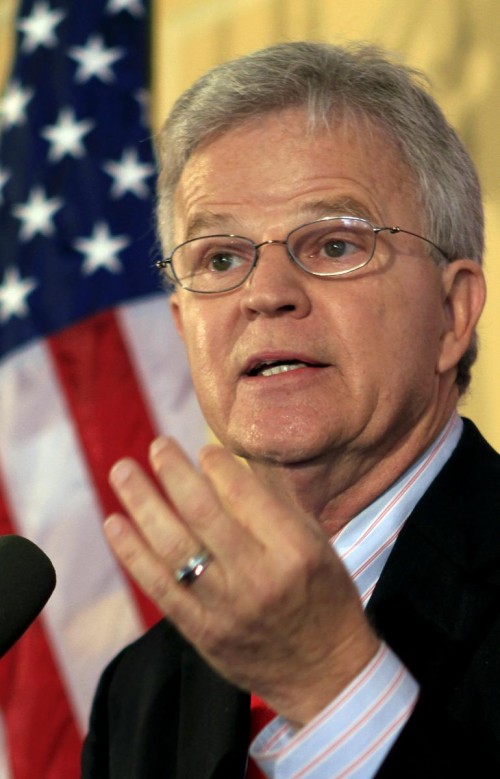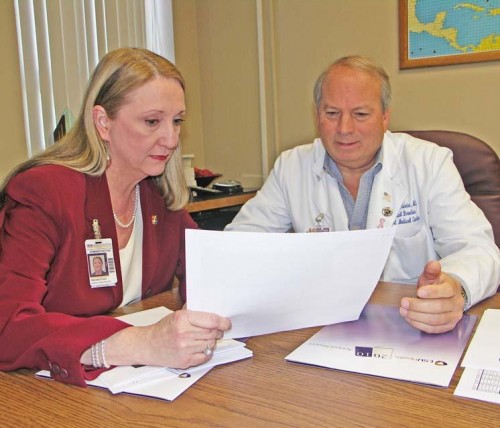Monday, Feb. 20
February 20, 2012
Who’s Your Buddy?
February 22, 2012Seven hospitals and two science centers within the LSU Health Care System face a March 5 deadline. That is when a $29 million budget gap, involving $34 million saved from mid-year job cuts, elimination of services and removal of patient beds, is expected to close throughout the state-run public medical care organization.
Some facilities simply wait for the amputations to occur while others are fighting back with efforts through legislators and going public regarding their plight.
LSU Health Care System executives blame Gov. Bobby Jindal’s approach to operating the state budget, in which he has targeted health care and education as the first places from which to recover revenue, for their problems.
The governor has accused LSU of mismanaging funds and maintaining a tradition of secrecy along with free spending of taxpayer money.
Sound of Silence
Shortly after LSU supervisors approved removal of jobs and services on Feb. 3, public access to information and responses from administrators was hushed. LSU Health Care System Vice President of Health Affairs Fred Cerise did go public with his comment that patients that might have services eliminated could, “… receive services elsewhere.”
Louisiana State Medical Society Board of Governors member and Morgan City otolaryngologist Dr. Irving Blatt, who was among the founders of Leonard J. Chabert Medical Center in Houma, claims that information regarding the LSU system is closely guarded and financial dealings are protected by intimidation from executives.
“I know one nurse who was fired [because she threatened to reveal inside information],” Blatt said. “[Chabert] is suffering, and they are suffering because of a lousy system.”
Statistical information obtained by the Tri-Parish Times offered a look at Chabert and how it compares to other hospitals within the system, albeit a comparison that Blatt, along with Chabert CEO Rhonda Green and Chabert Chief of Medicine Dr. Michael Garcia contend is difficult to make because of facility size, community demographics, medical offerings, financial activity and overall performance.
When put side by side on paper, the Houma facility that services Terrebonne, Lafourche, St. Mary and Assumption parishes, is examined.
“The problem is the system,” Blatt said. “LSU is the principal problem. [The board of supervisors] don’t want to meet with anybody. Nothing is transparent and they get away with it.”
* Drawing the Data
Chabert Medical Center is in line to lose 80 jobs across the board from its 945 full-time, 63 part-time and 50 flex-time employees. It has been directed to close its neonatal intensive care unit along with labor and delivery services. The hospital has 156 licensed patient beds that are to be reduced in number on a floating basis, leaving room for added patient census during crisis situations such as a major hurricane.
Chabert is the first hospital in the state of Louisiana and second in the United States to have received accreditation from the National Committee for Quality Assurance with its medical home model, which is praised for being patient centered and team based. One element includes having doctors that work in a closed staff environment, meaning they are hospital employees as opposed to doctors that rent space and are available at hospitals based on their own schedules.
This is an approach that Green and Garcia contend offers greater attention to detail, enhances patient service, improves financial accountability while balancing the numbers with medical requirements, and generates an atmosphere of community among staff members and within a service area at large.
During 2010, Chabert listed 215,654 outpatient visits, 40,212 emergency room visits and 3,845 patient admissions.
With an operating budget of more than $1.7 million during its 2010-2011 fiscal year, Chabert received more than $6 million in state funds. Remaining budgetary elements are listed as $11.8 million from Medicare, $28.9 million from Medicaid, uncompensated charity care at approximately $52 million, commercial revenue of more than $4.9 million, self-pay patient fees of approximately $1.4 million and miscellaneous revenue exceeding $5 million.
“Over half of our patients have a payer source ranging from Medicare, Medicaid and private insurance,” Green said. “Our patients choose to come here.”
According to Green, Chabert offers an overall economic impact of $275 million to the region.
* Connect the Numbers
When placing Chabert next to the six remaining hospitals, two science centers and specialized clinics in the LSU Health Care System, daily per-patient costs, excluding service providers, for the group during 2011 averaged more than $1,585.
A closer examination of the raw data listed Chabert as having carried a daily per-patient cost of $1,200. The only lower daily per-patient cost in 2011, was $1,130 at W.O. Moss Regional Medical Center in Lake Charles.
Additional facilities and daily per-patient costs for 2011 include Bogalusa Medical Center in Bogalusa at $1,218, Huey P. Long Medical Center in Pineville at $1,310, E.A. Conway Medical Center in Monroe $1,441, University Medical Center in Lafayette $1,462, Lallie Kemp Medical Center in Independence $1,635, LSU Health Sciences Center in Shreveport $1,844, Earl K. Long Medical Center in Baton Rouge $1,861 and Interim LSU Public Hospital New Orleans at $2,752.
A fuller comparison is made once it is revealed that Chabert has 156 beds prior to cuts and how total patient costs stack up against this and other facilities.
Moss puts its daily per-patient cost as the lowest for the system in 2011, against being only a 16 pediatric and adult bed facility.
LSU Health Sciences Center has 424 beds, LSU Public Hospital has 217 beds, Conway has 158 beds, UMC has 117, Bogalusa has 90 beds, Earl K. Long has 175, Huey P. Long offers 60 and Lallie Kemp 17 beds.
“We get accused of not being efficient,” Green said. “We had 283 eligible Medicare admissions [in 2011]. Our hospital on average spent $16,470 to care for these people. So, operate very lean.”
* Earning a Way
Chabert is credited with being an income-generating facility within the LSU Health Care System. During 2010 the entire system listed 11 percent of its revenue mix as being self-generating.
A closer examination of independent money made by the so-called charity hospitals listed Chabert has having 9 percent of its revenue mix being self-generating funds.
Other self-generating shares include LSU Health Science Center at 14 percent, Bogalusa 11 percent, Moss 9 percent, Lallie Kemp and LSU Public Hospital both at 8 percent, UMC at 6 percent and E.K. Long with 5 percent and H.P. Long at 3 percent.
At the same time, state allocated funds for the LSU Health Care System during 2010 were listed as being 8 percent of the total revenue mix. This included Chabert with 6 percent of its mix being allocated from state coffers.
Remaining facilities and what they gained from the state budget proportioned to their revenue mix include LSU Health Science Center at 4 percent, UMC 6 percent, Bogalusa and LSU Public Hospital each at 7 percent, Lallie Kemp 11 percent, Conway and E.K. Long each 13 percent, Moss at 17 percent and H.P. Long at 21 percent.
Green explained that if that medical center had operated as an independent hospital, with no state revenue during 2011, it would have made approximately $101 million.
“Budgets can be kind of confusing,” Green said. “When you hear about state hospitals getting [taxpayer] money, all we actually get is a little over $6 million from state general funds. That money is supposed to be used to take care of prisoners. The rest of our $107 million budget, we have to see the patients, generate a charge and be reimbursed for it. We have to earn that. We cannot overspend the $107 million, but we have to collect that amount.”
“There are mechanisms in place in the country for caring for the poor,” Garcia said. “All states have access, but to get the money you have to actually see the patient and create a cost.”
Without $52 million in uncompensated charity care, Green admitted Chabert would have a difficult time standing on its own.
“Those are the people that come to us and have no income source at all. And that’s federal [coverage],” she said.
In order for any hospital within the LSU Health Care System to draw federal funds the state must first leverage a tax dollar to pull down federal dollars. “One dollar in [state] taxes gets us $3 back,” Garcia said. “The three to one match results in the $52 million, but we have to earn it. They don’t just hand it to you.”
* Giving or Getting
“[Chabert is] capable of generating funds and operating at a profit,” Blatt said. “Their problems can be solved by getting out of the system.”
Green and Garcia said they appreciate the sentiment people like Blatt have voiced, but to become suddenly independent from the LSU Health Care System might be easier said than accomplished because of the challenges involved with maintaining quality patient care and fiscal responsibility.
“If you help people remain healthy, you will have a healthy economy,” Green said. “We have been fiscally and medically responsible. I wish they would recognize that.”
“The combinations of processes that are in place to care for patients between case management, viewing charts and staying on top of quality measures collectively leads to a lower cost in health care,” Garcia said.
Green and Garcia said Chabert has developed a culture where all departments are made aware of their part of budget and work together to make medical care and health costs complement one another.
“I don’t know if we are more aggressive than the other hospitals, but our outcome is different,” Garcia said. “It is just a matter of people doing their jobs.”
Leonard J. Chabert Medical Center CEO Rhonda Green and Chief of Medicine Dr. Michael Garcia look at comparative statistics between their facilities and others that are part of the LSU Health Care System. MIKE NIXON












